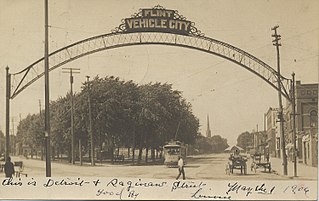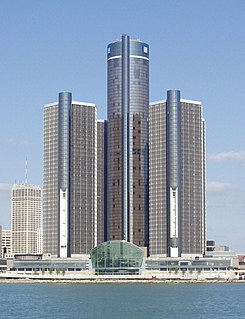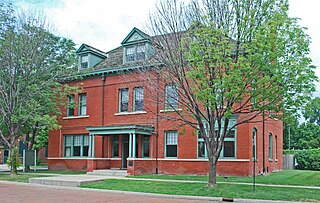Related Research Articles

General Motors Company (GM) is an American multinational automotive manufacturing corporation headquartered in Detroit, Michigan, United States. The company is the largest automobile manufacturer based in the United States and one of the largest worldwide. It was the largest automaker worldwide for 77 consecutive years, from 1931 when it overtook Ford Motor Company, until 2008, when it was overtaken by Toyota.

McLaughlin Motor Car Company Limited was a Canadian manufacturer of automobiles headquartered in Oshawa, Ontario. The company, founded by Robert McLaughlin, once was the largest carriage manufacturing factory in the British Empire.

Charles Williams Nash was an American automobile entrepreneur who served as an executive in the automotive industry. He played a major role in building up General Motors as its 5th President. In 1916, he bought Thomas B. Jeffery Company, makers of the popular Rambler automobile, renamed it Nash Motors, and played an independent role in an automobile industry increasingly dominated by the Big Three: General Motors, Ford, and Chrysler. His profits came from focusing on one well-designed car in the upper-medium price range. He bought several distressed companies in Wisconsin, merging them and installing advanced managerial accounting procedures while cutting costs and focusing on long-term growth. He retired as president in 1932, but remained chairman of the board. His major acquisition was the merger in 1937 with the Kelvinator Company, which made refrigerators. During World War II, Nash-Kelvinator greatly expanded to manufacture aircraft engines and parts.

William Crapo Durant was a leading pioneer of the United States automobile industry. He created a system in which a company held multiple marques – each seemingly independent, with different automobile lines – bound under a unified corporate holding company. Durant, along with Frederic L. Smith, co-founded General Motors, as well as Chevrolet with Louis Chevrolet. He also founded Frigidaire.

Durant Motors Inc. was established in 1921 by former General Motors CEO William "Billy" Durant following his termination by the GM board of directors and the New York bankers who financed GM.

Fisher Body was an automobile coachbuilder founded by the Fisher brothers in 1908 in Detroit, Michigan. A division of General Motors for many years, in 1984 it was dissolved to form other General Motors divisions. Fisher & Company continues to use the name. The name and its iconic "Body by Fisher" logo were well known to the public, as General Motors vehicles displayed a "Body by Fisher" emblem on their door sill plates until the mid-1990s.

Lansing Car Assembly was a General Motors automobile factory in Lansing, Michigan. It contained two elements, a 1901 automobile plant in downtown Lansing, and the 1920 Durant Motors factory on Lansing's Far Westside.

Buick City was a name applied to the former Buick home plant following major renovations completed during the early 1980's to better compete with Japanese producers. The plant was a massive automobile manufacturing complex in the northeast of Flint, Michigan. Elements of the 235-acre (950,000 m2) complex dated from before 1904, when it was known as Flint Wagon Works. Once General Motors assumed operations all aspects of Buick vehicles were constructed, and it became known as Buick City in 1985. The engine block and cylinder heads were cast at Defiance Foundry in Defiance, Ohio and earlier at Saginaw Metal Casting Operations in Saginaw, Michigan.

General Motors of Canada Company, commonly known as GM Canada, is the Canadian subsidiary of General Motors. It is headquartered in Oshawa, Ontario, Canada.

Wilmington Assembly was a General Motors automobile factory in Wilmington, Delaware. The 3,200,000-square-foot (300,000 m2) factory opened in 1947, and produced cars for GM's Chevrolet, Pontiac, Saturn, Opel, Buick and Daewoo brands during its operation. GM closed the plant on July 28, 2009.

Flint, Michigan is a city which previously relied on its automotive industry, and still does to an extent. Over the past several decades, General Motors plants in Genesee County have experienced re-namings, management shifts, openings, closures, reopenings, and spinoffs.

The history of General Motors (GM), one of the world's largest car and truck manufacturers, dates back more than a century and involves a vast scope of industrial activity around the world, mostly focused on motorized transportation and the engineering and manufacturing that make it possible. Founded in 1908 as a holding company in Flint, Michigan, as of 2012 it employed approximately 209,000 people around the world. With global headquarters at the Renaissance Center in Detroit, Michigan, United States, General Motors manufactures cars and trucks in 35 countries. In 2008, 8.35 million GM cars and trucks were sold globally under various brands. Current auto brands are Buick, Cadillac, Chevrolet, GMC, and Wuling. Former GM automotive brands include La Salle, McLaughlin, Oakland, Oldsmobile, Opel, Pontiac, Hummer, Saab, Saturn, Vauxhall, Daewoo and Holden.

The Durant-Dort Carriage Company Office is a National Historic Landmark owned by General Motors. A late 19th-century office building located at 316 West Water Street in Flint, Michigan, it was built and occupied by GM's parent, Durant-Dort, followed by Dort Motor Car Company, until 1924.
Pontiac Assembly was one of four General Motors assembly plants in Pontiac, Michigan located along Baldwin Avenue. It served as the main facility for Pontiac Motor Division since it was built in 1927. It is across the street from the currently operational Pontiac Metal Center, which was the original location for the Oakland Motor Car Company, which Pontiac evolved into. The location that Oakland inhabited was the original site of Cartercar when GM bought the company in 1909 by William Durant. The plant ceased production of full-size Pontiacs after the 1980 model year, and was idled on August 6, 1982.
ACDelco is an American automotive parts brand owned by General Motors (GM). Factory parts for vehicles manufactured by GM are consolidated under the ACDelco brand, which also offers aftermarket parts for non-GM vehicles. Over its long history it has been known by various names such as United Motors Corporation, United Motors Service, and United Delco. The brand "ACDelco" should not be confused with GM's former AC Delco Systems, formed in 1994 from the merger of AC Rochester Division and Delco Remy Division. In 1995 Delphi Automotive Systems absorbed AC Delco Systems.

Durant-Dort Carriage Company was a manufacturer of horse-drawn vehicles in Flint, Michigan. Founded in 1886, by 1900 it was the largest carriage manufacturer in the country.
Harry Hoxie Bassett was an American automotive industry executive and president of Buick Motor Car Company, division of General Motors from 1920 through 1926.
Flint Wagon Works of Flint, Michigan, manufactured wagons from the early 1880s. One of the world's most successful horse-drawn vehicle makers they formed with their Flint neighbours a core of the American automobile industry. In 1905 Flint was promoting itself as Flint the Vehicle City. The former site is now located in the neighborhood of Flint as "Carriagetown".

Durant-Dort Factory One is a former cotton textile, carriage, and automobile factory in Flint, Michigan, that is now an archive and a center for research, meetings, and the community. The building was constructed in 1880 as a cotton textile factory. It produced carriages for the Durant-Dort Carriage Company from 1886 to 1917 and then produced cars for the Dort Motor Car Company from 1917 to 1924. It is often considered the birthplace of General Motors (GM).
Saginaw Metal Casting Operations is an automobile engine foundry plant in Saginaw, Michigan. Opened under GM management in 1919, the factory produces engine blocks and cylinder heads for General Motors vehicles. The factory currently occupies 1.9 million square feet on 490 acres. The location was originally the Marquette Motor Company until acquired by William Durant in 1909 when the car was discontinued in 1911. During World War I, it was used to manufacture mortar shells for the US Ordnance Corps, then was repurposed for engine block casting when operations at Northway Motor and Manufacturing Division ended in 1925. Historically in September 1927 it was known as the Chevrolet Grey Iron Foundry. In the past when it was called GM-Saginaw Product Company (SPC) a cloverleaf casting symbol mark was cast onto the iron component.